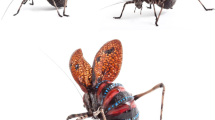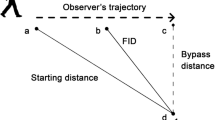Abstract
Most studies examining escape behaviour have considered single approaches and single fleeing responses; few have considered how organisms’ response is influenced by persistent pursuit. We explored fleeing behaviour of two grasshopper species to test whether they modified escape behaviour when approached repeatedly. Schistocerca alutacea did not increase flight initiation distance (FID) upon repeated approach but fled farther. Psinidia fenestralis increased its FID on the second approach but decreased its flight distance over successive escapes. Both species showed a bimodal pattern of flight direction, either flying directly away or flying perpendicular to the direction of the observer’s approach. Neither species showed a significant pattern of flight direction or change in flight direction with successive escapes. Most (88 %) P. fenestralis initially landed on sand, but after repeated approaches an increasing proportion landed in grass and hid. Both species therefore changed escape behaviour with persistent pursuit but used different tactics, suiting their flight ability or camouflage, and optimised habitat use. Three grasshopper species have now been examined for responses to repeated approach by predators and all show different tactics supporting escape decision theory. Our results emphasise the variety of escape responses across species and how the dynamic nature of escape responses vary according to an animal’s situation. Rather than single optimum escape options, each grasshopper species shows a range of responses, which vary with risk from persistent predators. Although grasshoppers provide an excellent model, it would be profitable to examine responses of a range of species according to levels of predation risk.




Similar content being viewed by others
References
Amo L, López P, Martín J (2004) Wall lizards combine chemical and visual cues of ambush snake predators to avoid overestimating risk inside refuges. Anim Behav 67:647–653
Banjo AD, Lawal OA, Songonuga EA (2006) The nutritional value of fourteen species of edible insects in southwestern Nigeria. Afr J Biotechnol 5:298–301
Bateman PW, Fleming PA (2006) Sex, intimidation and severed limbs: the effect of simulated predator attack and limb autotomy on calling behavior and level of caution in the field cricket Gryllus bimaculatus. Behav Ecol Sociobiol 59:674–681
Bateman PW, Fleming PA (2009) There will be blood: autohaemorrhage behaviour as part of the defence repertoire of an insect. J Zool (Lond) 278:342–348
Bateman PW, Fleming PA (2011a) Failure to launch? The influence of limb autotomy on the escape behavior of a semiaquatic grasshopper Paroxya atlantica (Acrididae). Behav Ecol 22:763–768
Bateman PW, Fleming PA (2011b) Who are you looking at? Hadeda ibises use direction of gaze, head orientation and approach speed in their risk assessment of a potential predator. J Zool (Lond) 285:316–323
Bateman PW, Fleming PA (2013a) The influence of the presence and size of silk decorations in webs on fleeing behaviour of Florida orb weaver spiders, Argiope florida (Aranaeidae). Can J Zool 91:468–472
Bateman PW, Fleming PA (2013b) Signaling or not-signaling: variation in vulnerability and defense tactics of armored ground crickets (Acanthoplus speiseri: Orthoptera, Tettigoniidae, Hetrodinae). J Insect Behav 26:14–22
Belovsky GE, Slade JB, Stockhoff BA (1990) Susceptibility to predation for different grasshoppers: an experimental study. Ecology 71:624–634
Broom M, Ruxton GD (2005) You can run—or you can hide: optimal strategies for cryptic prey against pursuit predators. Behav Ecol 16:534–540
Capinera JL, Scherer CW, Simkins JB (1997) Habitat associations of grasshoppers at the MacArthur agro-ecology research center, Lake Placid, Florida. Fla Entomol 80:253–261
Capinera JL, Scherer CW, Squitier JM (2001) Grasshoppers of Florida. University Press of Florida
Carrete M, Tella JL (2010) Individual consistency in flight initiation distances in burrowing owls: a new hypothesis on disturbance-induced habitat selection. Biol Lett 6:167–170
Cooper WEJ (1997) Threat factors affecting antipredatory behavior in the broad-headed skink (Eumeces laticeps): repeated approach, change in predator path, and predator’s field of view. Copeia 1997:613–619
Cooper WEJ (1998) Effects of refuge and conspicuousness on escape behavior by the broad-headed skink (Eumeces laticeps). Amphibia-Reptilia 19:103–108
Cooper WEJ (2006a) Dynamic risk assessment: prey rapidly adjust flight initiation distance to changes in predator approach speed. Ethology 112:858–864
Cooper WEJ (2006b) Risk factors and escape strategy in the grasshopper Dissosteira carolina. Behaviour 143:1201–1218
Cooper WEJ (2012) Risk, escape from ambush, and hiding time in the lizard Sceloporus virgatus. Herpetologica 68:505–513
Cooper WEJ, Avalos A (2010) Predation risk, escape and refuge use by mountain spiny lizards (Sceloporus jarrovii). Amphibia-Reptilia 31:363–373
Cooper WEJ, Frederick WG (2007) Optimal flight initiation distance. J Theor Biol 244:59–67
Cooper WEJ, Hawlena D, Pérez-Mellado V (2009) Effects of predation risk factors on escape behavior by Balearic lizards (Podarcis lilfordi) in relation to optimal escape theory. Amphibia-Reptilia 30:99–110
Cooper WEJ, Pérez-Mellado V, Hawlena D (2006) Magnitude of food reward affects escape behavior and acceptable risk in Balearic lizards, Podarcis lilfordi. Behav Ecol 17:554–559
Domenici P, Blagburn JM, Bacon JP (2011a) Animal escapology I: theoretical issues and emerging trends in escape trajectories. J Exp Biol 214:2463–2473
Domenici P, Blagburn JM, Bacon JP (2011b) Animal escapology II: escape trajectory case studies. J Exp Biol 214:2474–2494
Domenici P, Booth D, Blagburn JM, Bacon JP (2008) Cockroaches keep predators guessing by using preferred escape trajectories. Curr Biol 18:1792–1796
Dukas R (1998) Cognitive ecology: the evolutionary ecology of information processing and decision making. University of Chicago Press
Eterovick PC, Côrtes Figueira JE, Vasconcellos-Neto J (1997) Cryptic coloration and choice of escape microhabitats by grasshoppers (Orthoptera: Acrididae). Biol J Linn Soc 61:485–499
Fogarty MJ, Hetrick WM (1973) Foods of cattle egrets in north Central Florida. Auk 90:268–280
Hassenstein B, Hustert R (1999) Hiding responses of locusts to approaching objects. J Exp Biol 202:1701–1710
Higaki M, Ando Y (2003) Effects of crowding and photoperiod on wing morph and egg production in Eobiana engelhardti subtropica (Orthoptera: Tettigoniidae). Appl Entomol Zool 38:321–325
Humphries DA, Driver PM (1970) Protean defence by prey animals. Oecologia 5:285–302
Javůrková V, Šizling AL, Kreisinger J, Albrecht T (2012) An alternative theoretical approach to escape decision-making: the role of visual cues. PLoS ONE 7:e32522
Jones KA, Jackson AL, Ruxton GD (2011) Prey jitters; protean behaviour in grouped prey. Behav Ecol 22:831–836
Kotiaho J, Alatalo RV, Mappes J, Parri S, Rivero A (1998) Male mating success and risk of predation in a wolf spider: a balance between sexual and natural selection? J Anim Ecol 67:287–291
Kral K (2010) Escape behaviour in blue-winged grasshoppers, Oedipoda caerulescens. Physiol Entomol 35:240–248
Lee S-I, Hwang S, Joe Y-E, Cha H-K, Joo G-H, Lee H-J, Kim J-W, Jablonski PG (2013) Direct look from a predator shortens the risk-assessment time by prey. PLoS ONE 8:e64977
Martín J, López P (1999) When to come out from a refuge: risk-sensitive and state-dependent decisions in an alpine lizard. Behav Ecol 10:487–492
Martín J, López P (2003) Changes in the escape responses of the lizard Acanthodactylus erythrurus under persistent predatory attacks. Copeia 2003:408–413
Masaki S, Walker TJ (1987) Cricket life cycles. Evol Biol 21:349–423
Petersen BS, Christensen KD, Falk K, Jensen FP, Ouambama Z (2008) Abdim’s Stork Ciconia abdimii exploitation of Senegalese grasshopper Oedaleus senegalensis in South-eastern Niger. Waterbirds 31:159–305
Pitt WC (1999) Effects of multiple vertebrate predators on grasshopper habitat selection: trade-offs due to predation risk, foraging, and thermoregulation. Evol Ecol 13:499–515
Reimers E, Loe LE, Eftestøl S, Colman JE, Dahle B (2009) Effects of hunting on response behaviors of wild reindeer. J Wildl Manag 73:844–851
Rind FC, Simmons PJ (1992) Orthopteran DCMD neuron: a reevaluation of responses to moving objects. I. Selective responses to approaching objects. J Neurophysiol 68:1654–1666
Rodríguez-Prieto I, Fernández-Juricic E (2005) Effects of direct human disturbance on the endemic Iberian frog Rana iberica at individual and population levels. Biol Conserv 123:1–9
Ruddle K (1973) The human use of insects: examples from the Yukpa. Biotropica 5:94–101
Scott D (1984) The feeding success of cattle egrets in flocks. Anim Behav 32:1089–1100
Stankowich T (2008) Ungulate flight responses to human disturbance: a review and meta-analysis. Biol Cons 141:2159–2173
Tikkanen P, Muotka T, Huhta A (1996) Fishless-stream mayflies express behavioural flexibility in response to predatory fish. Anim Behav 51:1391–1399
Ydenberg RC, Dill LM (1986) The economics of fleeing from predators. Adv Stud Behav 16:229–249
Author information
Authors and Affiliations
Corresponding authors
Additional information
Communicated by J. C. Choe
Rights and permissions
About this article
Cite this article
Bateman, P.W., Fleming, P.A. Switching to Plan B: changes in the escape tactics of two grasshopper species (Acrididae: Orthoptera) in response to repeated predatory approaches. Behav Ecol Sociobiol 68, 457–465 (2014). https://doi.org/10.1007/s00265-013-1660-0
Received:
Revised:
Accepted:
Published:
Issue Date:
DOI: https://doi.org/10.1007/s00265-013-1660-0




